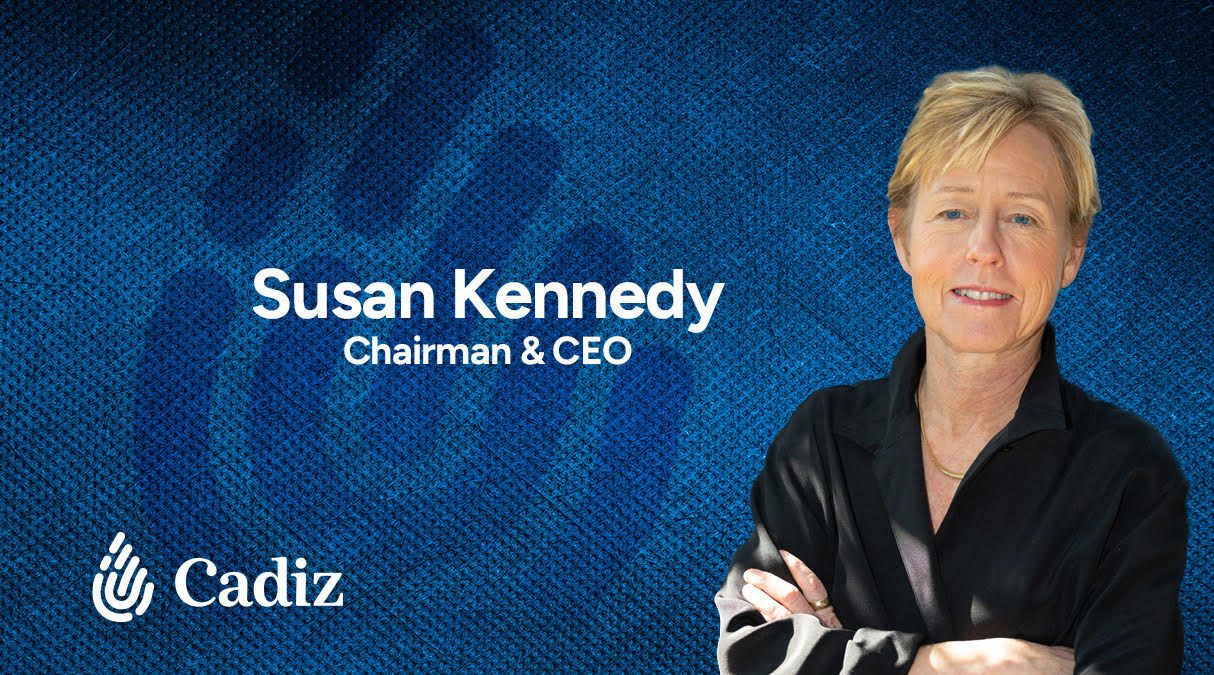Susan Kennedy is the Chair and CEO of Cadiz, a Los Angeles-based water solutions company with infrastructure assets across Southern California. Appointed to the Board in 2021, elected Chair in 2022, and named CEO in 2024, Kennedy brings decades of leadership in both government and clean energy. She previously served as Chief of Staff to Governor Arnold Schwarzenegger, Cabinet Secretary to Governor Gray Davis, and Commissioner of the California Public Utilities Commission, where she oversaw water utility regulation. A longtime policymaker and entrepreneur, Kennedy played a key role in negotiating major water infrastructure and environmental restoration projects, including the $8 billion San Francisco Bay Delta restoration and early Salton Sea recovery efforts.
What urgent problem is the Cadiz Water Project solving — and why is it needed now more than ever?
We’re facing a water infrastructure crisis, not a water shortage. Climate change has shifted how water moves across the planet—it no longer falls as predictable snowpack in the north but as erratic, torrential rain in the south. Our current infrastructure wasn’t built for that, so we’re losing massive volumes of water to evaporation and runoff. Cadiz is solving the urgent problem of how to access, store, and deliver clean water to communities that have no future without it. This is especially critical now, as existing supplies from the Colorado River and Northern California continue to decline.
In simple terms, how does the Cadiz Water Project work, and what makes it different from other water solutions in California?
We own 45,000 acres in the Mojave Desert, right where California, Arizona, and Nevada meet. This land sits atop a naturally recharging aquifer fed by rain from the surrounding mountains. We intercept water as it moves through the watershed—before it evaporates—and transport it to communities in need. What makes Cadiz different is we’re not reallocating dwindling resources like others—we’re bringing new water to the table. On top of that, we offer integrated solutions: water supply, infrastructure, and purification systems that make the water safe and accessible.
You’re reusing oil and gas pipelines to move water — how did that idea come about, and what impact does it have?
The idea came from necessity. Traditional water delivery infrastructure—like canals and aqueducts—costs billions and takes generations to build. Meanwhile, there are millions of miles of idle oil and gas pipelines already in the ground. These steel pipes don’t retain hydrocarbons and can be cleaned and retrofitted. By using them, we avoid tearing up land and dramatically reduce the cost and timeline of getting water to remote areas. It’s efficient, innovative, and a smarter use of existing assets in a time when urgency matters.
How are you making sure the desert ecosystem stays protected during this project?
It starts with understanding the source. We’re tapping into a renewable, naturally recharging aquifer—not a fragile or finite resource. The water we collect is on its way to evaporate at dry lake beds, so we’re not diverting anything vital to surface ecosystems. We’re also careful not to draw too close to the saline areas to avoid contamination. With sound science and careful monitoring, we can provide water without causing harm to the environment.
Who will benefit most from this project — and what could this mean for underserved communities across California?
The biggest beneficiaries will be the high desert communities—places like Barstow, Yermo, Daggett, Lancaster, and Palmdale—that have been left out of legacy water systems. These areas rely on costly, long-distance pumping and have water quality issues like nitrates and arsenic. Our project will bring clean, affordable water directly to them, helping to recharge their local basins and secure their future. We’re also working with tribal nations and underserved municipalities to ensure they have equity in the infrastructure—not just access. This could be a game-changer for water justice in the West.

